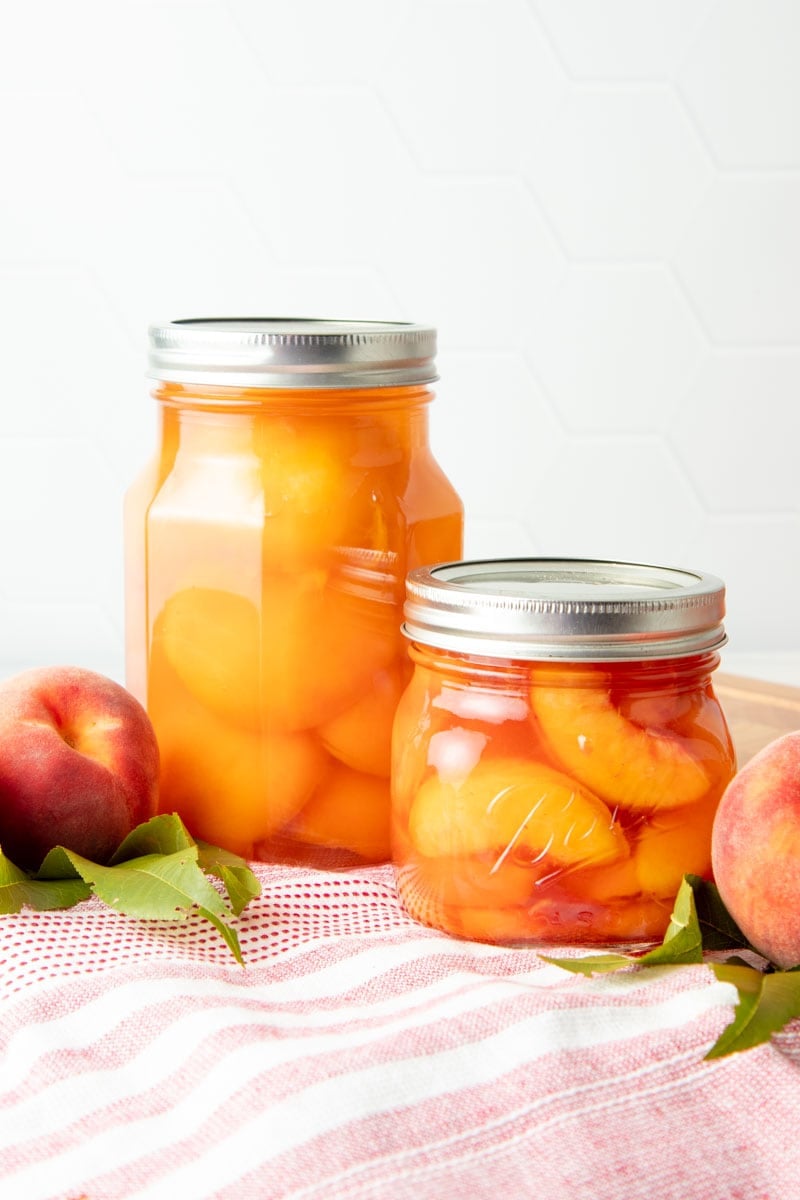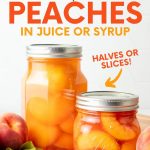Canning peaches is a must-do each summer in my house. Having jars of sunny yellow peaches on my shelves brings me so much joy! Peaches are one of the very best fruits for canning (right up there with canning applesauce). We use canned peaches all year long in our house. You’ll find us using them in school lunchboxes, in yogurt bowls, on top of pancakes, and even tossed on top of a bowl of ice cream.
Traditionally, peaches are canned using a heavy syrup made thick and sweet with granulated sugar. You can do that (and we’ll show you how), but it is also perfectly safe to can peaches in light syrup, juice, water, and even using unrefined sweeteners. We’ll cover all this in our tutorial below. Let’s get canning!
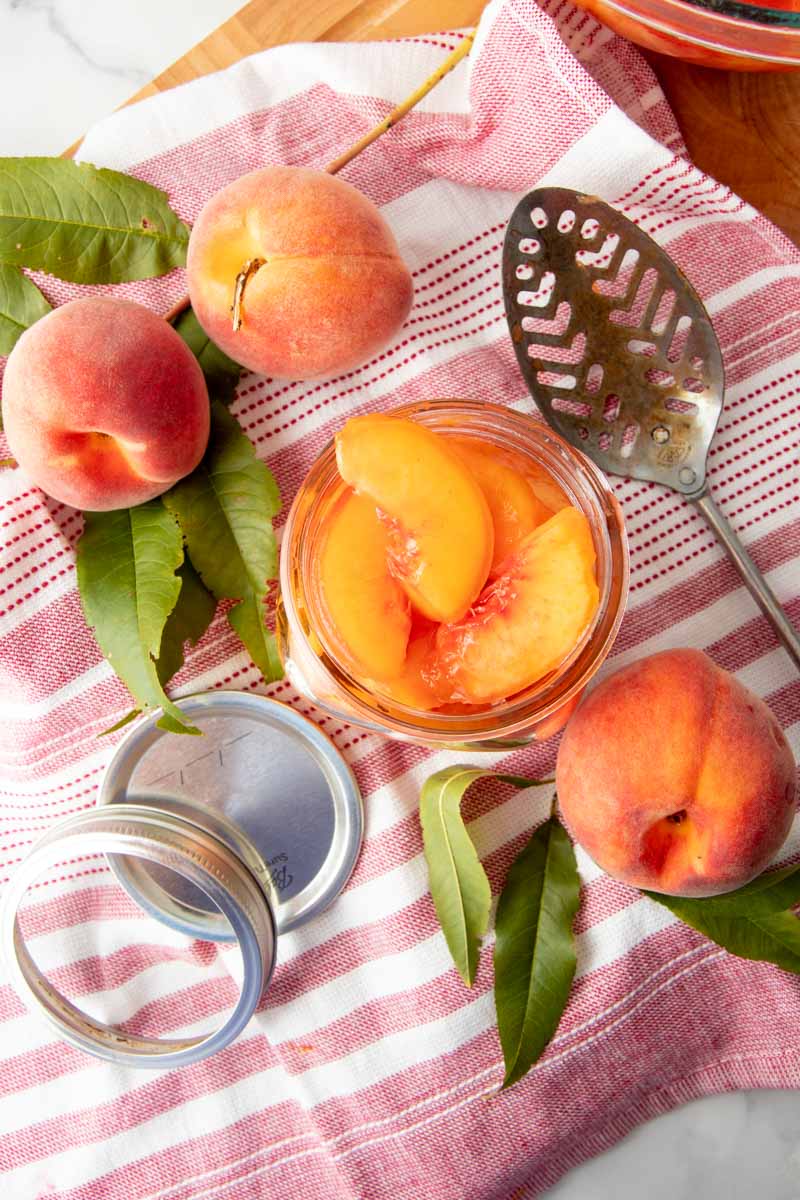
What are the best peaches for canning?
Not just any peach will do for canning. Here’s what you should look for when shopping for canning peaches:
- Ripe, but still somewhat firm peaches. Ripe peaches are the easiest to peel and have the best flavor and texture. Peaches that are overly ripe are difficult to work with and can lose their texture during processing.
- Yellow peaches, not white. Only yellow peaches are acidic enough to be water bath canned safely—white peaches can have a higher pH level, or be too alkaline, so they aren’t considered safe to can.
- Freestone peaches. There are three kinds of peaches—freestone, clingstone, and semi-freestone. Their name tells you basically everything you need to know! In clingstone peaches, the flesh “clings” to the pit. In freestone peaches, the flesh is separate from the pit. Any kind works for canning, but it is much easier to work with freestone or semi-freestone peaches. It’s worth seeking out freestone peaches, especially if you are planning on doing a large batch of peach canning.
Wholefully Protip
If you do end up canning with clingstone peaches, a peach pitter and slicer can save you a ton of time!
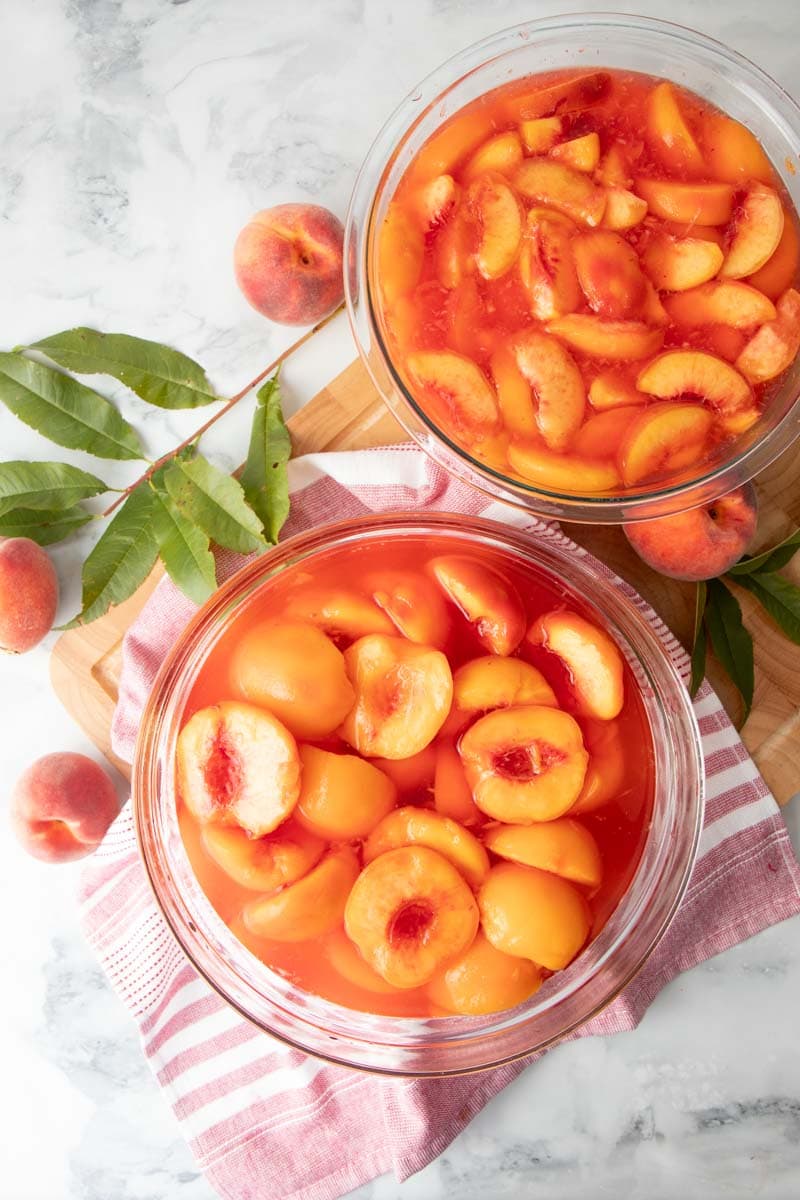
Do peaches need to be pressure canned?
No need to dust off your pressure canner! Yellow peaches are acidic enough that they can be safely canned in a water bath canner. Fruit with a pH lower than 4.6 can safely be canned with this method, and yellow peaches ring in around 3.4-4.0.
White-flesh peaches can have a pH of 4.6 or higher, so they cannot be safely canned. If you’d like to preserve white peaches, we recommend freezing them instead.
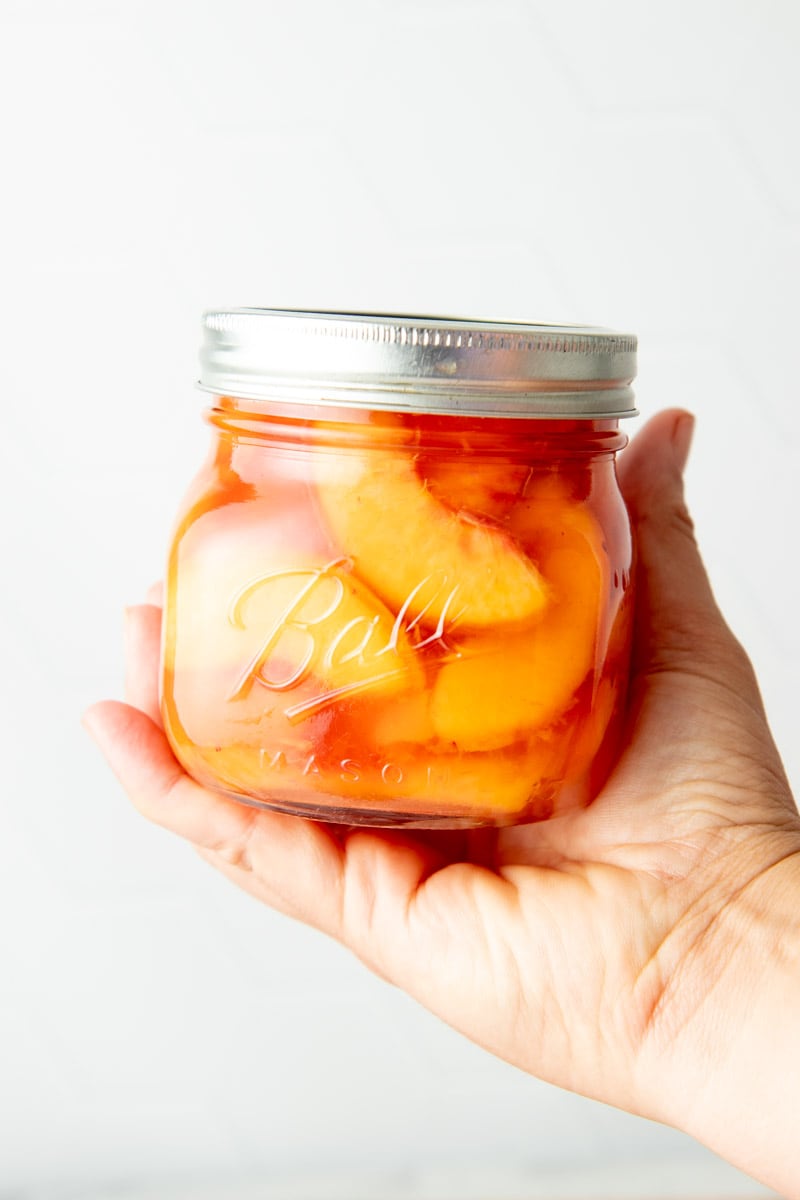
How do I prepare peaches for canning?
Peaches are one of the easiest foods to prep for canning. Here’s all you need to do:
- Peel them.
- Pit them.
- Cut into either halves or slices.
- Treat with a solution to prevent browning. We like using Ball® Fruit Fresh, but you can also use lemon juice.
Okay, but do I *really* have to remove the peach peels?
From a food safety standpoint, no you don’t. But from a good eats standpoint? Yes. You have to peel your peaches.
Just like when you are canning tomatoes, leaving the peels on the peaches can lead to unpleasant results later. Peach peels tend to get tough, slimy, or have other strange texture changes after processing. They also can make your peaches taste bitter when processed at high heat.
No worries, peeling peaches is a breeze (and oddly satisfying). We’ll teach you how.
How do you keep peaches from turning brown when canning?
When cut or peeled peaches brown, it is because of oxidation—enzymes in the fruit react with the oxygen in the air. A little bit of added acidity will do the trick to keep your peaches their lovely yellow color. We prefer to use Ball® Fruit Fresh, but you can also mix some bottled lemon juice into a bowl of cold water to create a bath for the fruit.
What’s the best way to peel peaches?
After a quick blanch and dip in an ice bath, the peel of a peach slips right off. Here’s how to do it:
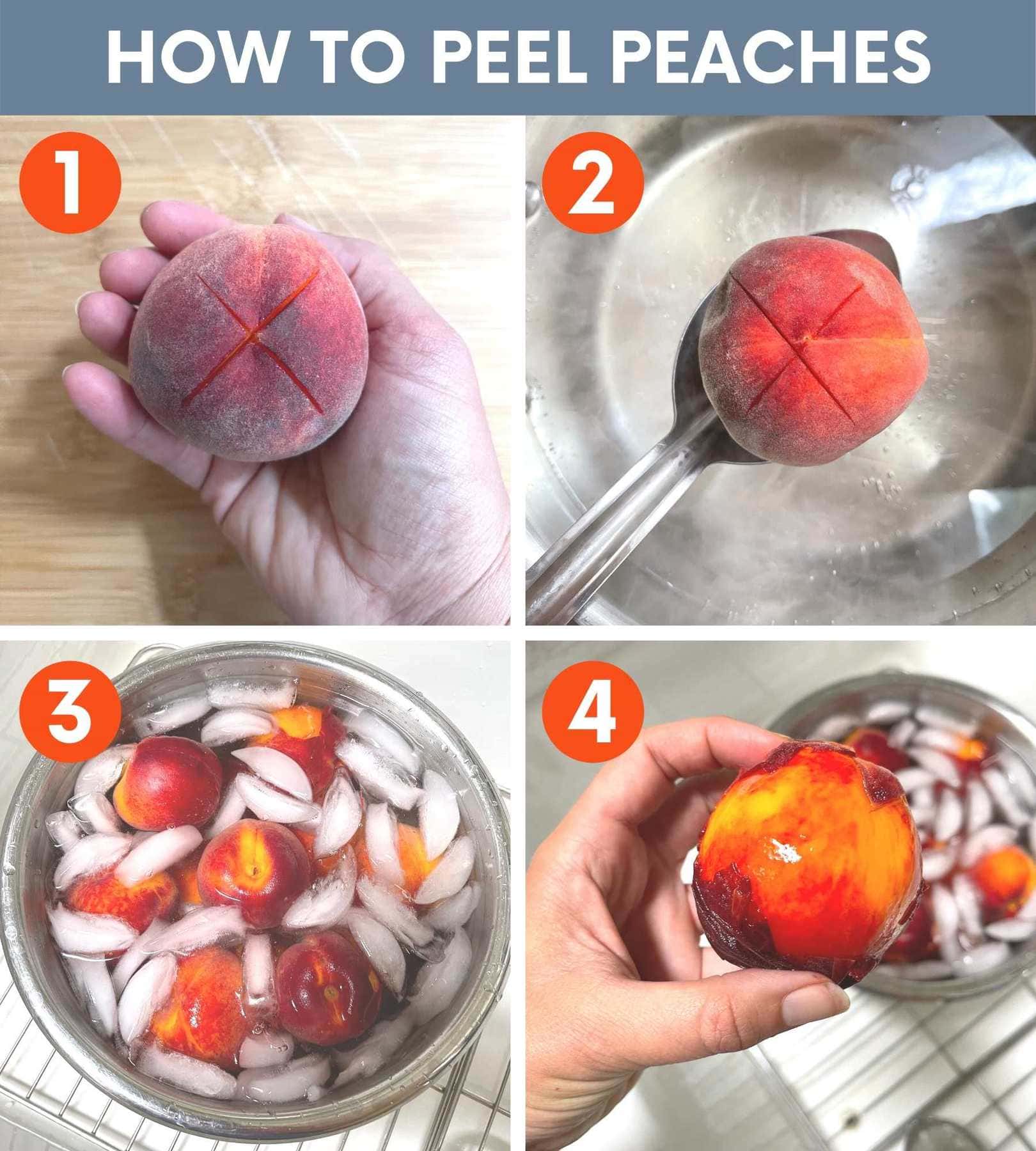
- Bring a large pot of water to boil. Fill a large bowl with cold water and ice. Using a sharp knife, cut an “X” into the bottom of each peach.
- Plunge the ripe peaches into the boiling water for 20-30 seconds.
- Remove with a slotted spoon, and immediately plunge into the bowl of ice water to stop cooking.
- The peel should already start to slip off of the chilled peaches, so just use your fingers to remove it the rest of the way.
Wholefully Protip
If the peels aren’t slipping off your peaches easily, it can either be because you didn’t quite blanch them long enough or your peaches aren’t ripe enough.
Is it better to can peach halves or peach slices?
Canning either peach halves or peach slices is the same process—it’s just a matter of how you think you’ll use the final product. We typically can peach slices in our house, because that’s what we use the most often, but canning peach halves saves you the step of cutting slices. So it’s all a matter of personal preference!
Is it better to raw-pack or hot-pack peaches?
You can either raw-pack (place peaches raw into your canning jars) or hot-pack (warm peaches first before adding into your jars). Both are perfectly safe.
The benefit to hot-packing peaches is that pre-warming the peaches in cooking liquid breaks down some of the air pockets in the hot fruit, which prevents them from floating as much in a jar once it has been processed. You can also slightly reduce your processing time since the peaches are pre-warmed.
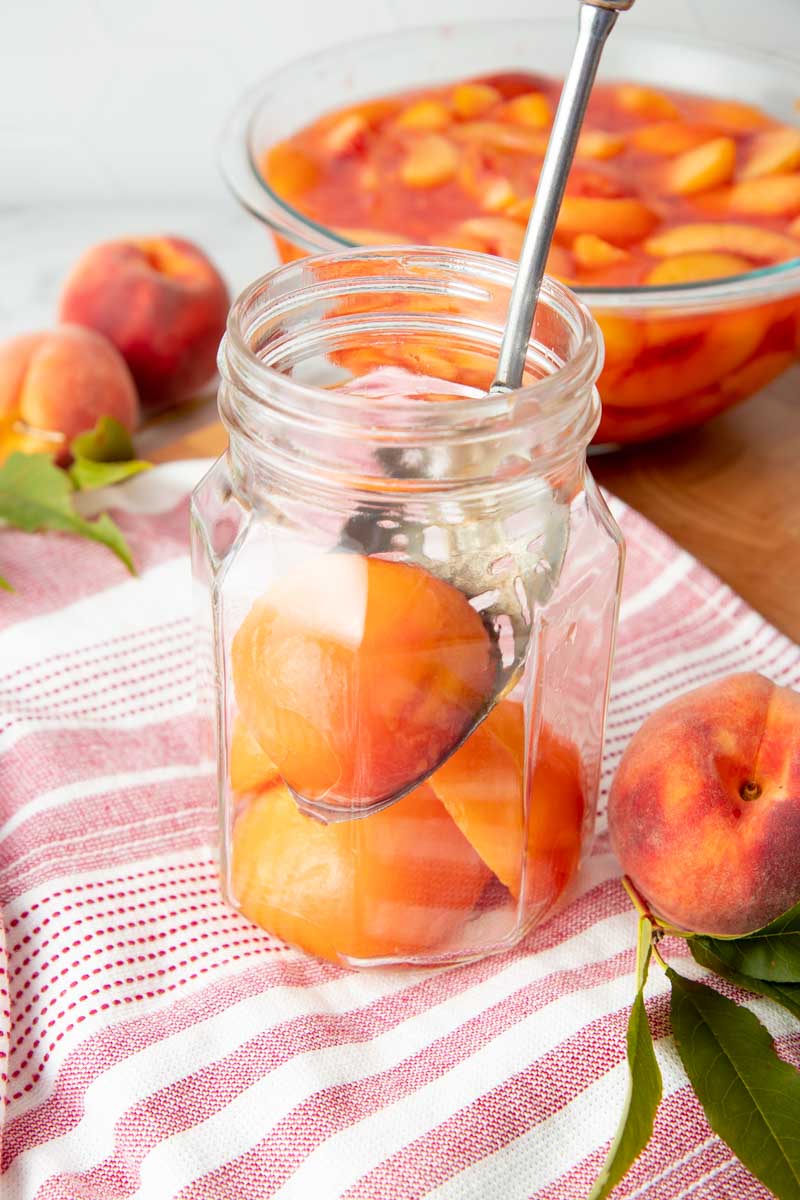
The big benefit of raw-packing peaches is…well…less work! I’m all about saving a step, so we always raw-pack peaches in our house. Floating peaches eventually settle back down in a jar on the shelf anyway.
Is it possible to can peaches without sugar?
Yes! Peaches can be safely canned in sugar syrup, honey syrup, fruit juice, and even water.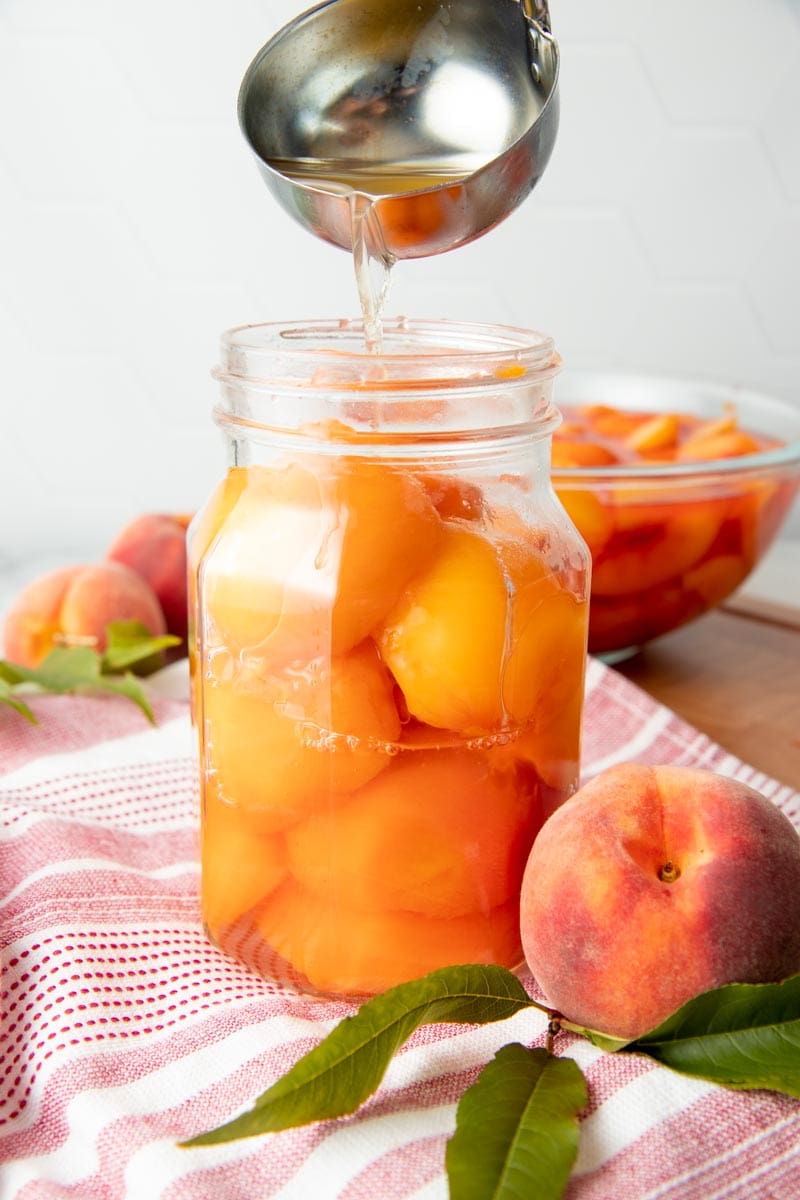
What liquid do I can peaches in?
It is safe to can peaches in a variety of different liquids. Here’s the skinny on the most common ones:
- Sugar Syrup: The most common way to can peaches is in a syrup made of granulated sugar and water. It is arguably the best way to preserve the texture, color, and flavor of your peaches. You can customize how much sugar you use based on the desired result (we have a chart below).
- Maple Syrup or Honey Syrup: You can also make syrups using unrefined sugars in place of the granulated sugar. This is our preferred method for canning peaches.
- Fruit Juice: Peaches may be canned in apple juice or white grape juice instead of syrup. You must use the hot-pack method when canning in fruit juice. You’ll see a large reduction in the quality of color, flavor, and texture.
- Water: You can safely can peaches in just water. However, this will result in the lowest preservation of color, flavor, and texture. You must use the hot-pack method when canning in water.
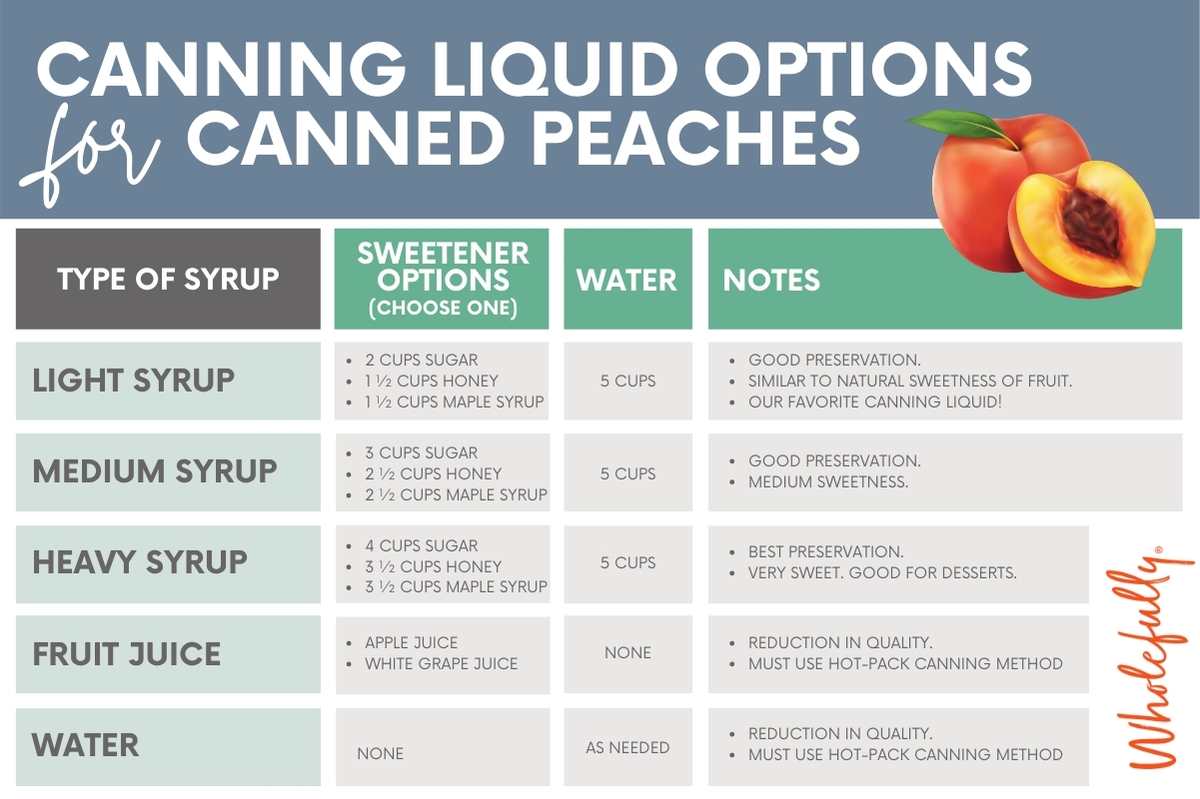
Do you have to use lemon juice when canning peaches?
Nope! Yellow peaches are acidic enough on their own that you don’t need to add more acidity with lemon juice or citric acid to safely can them. However, you’ll want to use either lemon juice or Ball® Fruit Fresh to treat the peaches before canning to prevent browning.
How to can peaches:
Canning peaches is a breeze, and they are one of the best fruits for folks new to home canning to put up. Here’s how you do it:
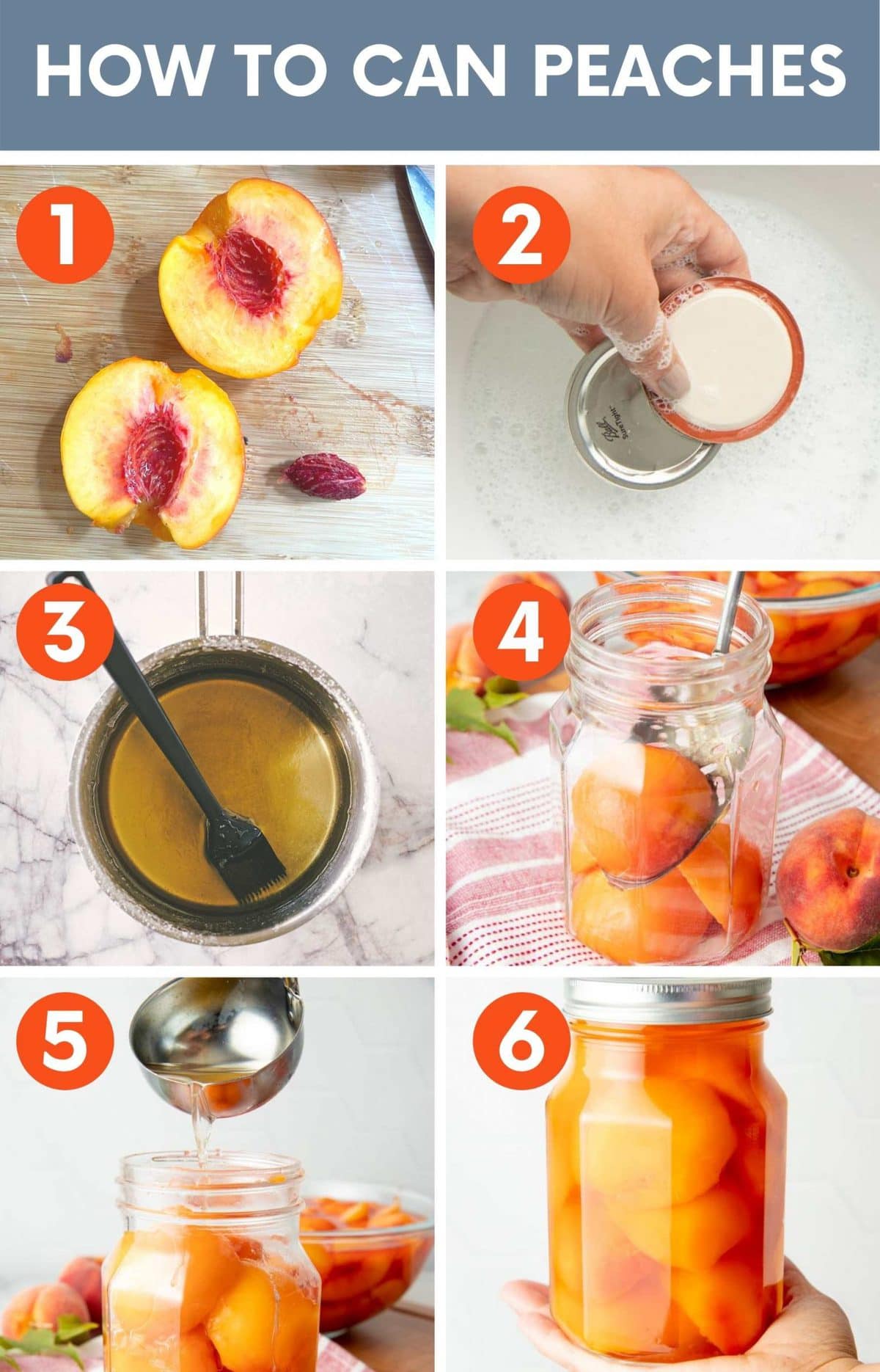
- Prepare your peaches by peeling, pitting, and cutting into halves or slices.
- Prepare your boiling water canner, jars, and lids (see our Canning 101 guide for more details).
- Prepare your canning syrup according to the chart above. Heat ingredients over medium-high heat until combined and hot. Keep syrup hot during canning. If using the hot-pack method: drop the prepared peaches into the hot canning liquid. Warm over medium-low heat until warmed through.
- For both raw-pack method and hot pack-method: pack peaches into hot jars. If canning peach halves, layer them cavity side down, in overlapping layers.
- Ladle hot canning liquid over them, leaving 1/2-inch headspace. Remove air bubbles.
- Wipe jar rims, place the lids on top, and screw bands on, tightening until just fingertip tight. Process filled jars in a boiling water canner. Process raw-packed pints for 25 minutes and quarts for 30 minutes and hot-packed pints for 20 minutes and quarts for 25 minutes. Remove jars and cool. Check lids for seal—lids should not flex when the center is pressed.
Can you freeze peaches before canning?
Sure can! But only if you plan on making peach jam. The freezing process breaks down the structure of the peaches in a way that makes them unsuitable for canning in halves or slices. Frozen peaches work great for both peach jam and peach wine, though!
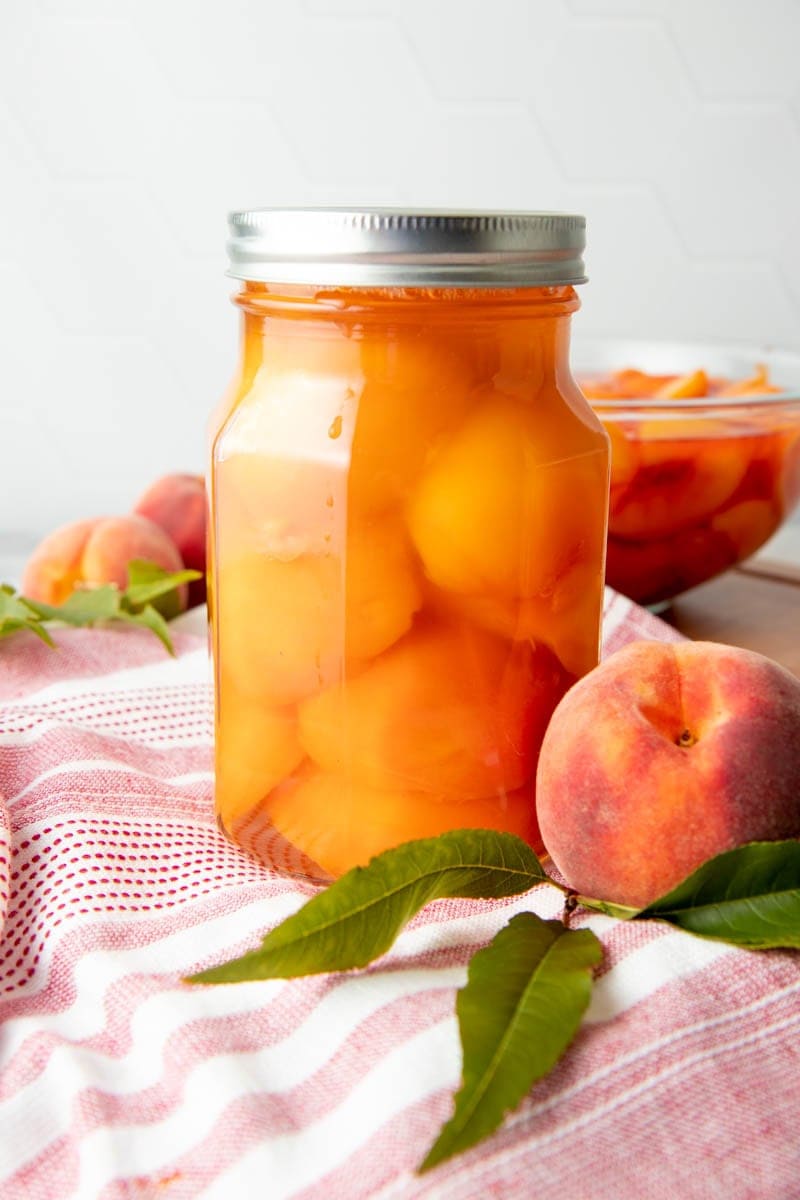
How long do you process peaches in a water bath?
It all depends on the size of your jars and whether you raw-packed or hot-packed the peaches:
- For raw-packed pints: 25 minutes
- For raw-packed quarts: 30 minutes
- For hot-packed pints: 20 minutes
- For hot-packed quarts: 25 minutes
Protip: Adjusting for Altitude
If you are canning at a high altitude, you will need to increase your processing time accordingly. Use this chart from Ball to determine your new canning time.
How long after opening a jar of canned peaches will they keep in my refrigerator?
The answer to this depends on the canning liquid or syrup you used to to preserve your peaches. In general, the higher the ratio of sugar, the longer the peaches will keep in the fridge. When we make our peaches in light or medium syrup, we can usually get about a week in the fridge after opening.
Wholefully Protip
We always can peach slices in wide-mouth pint jars—this is the perfect amount to serve to our small family of three at a meal. We used to can in wide-mouth quart jars, but found we kept forgetting about half jars of peaches in the back of the fridge.
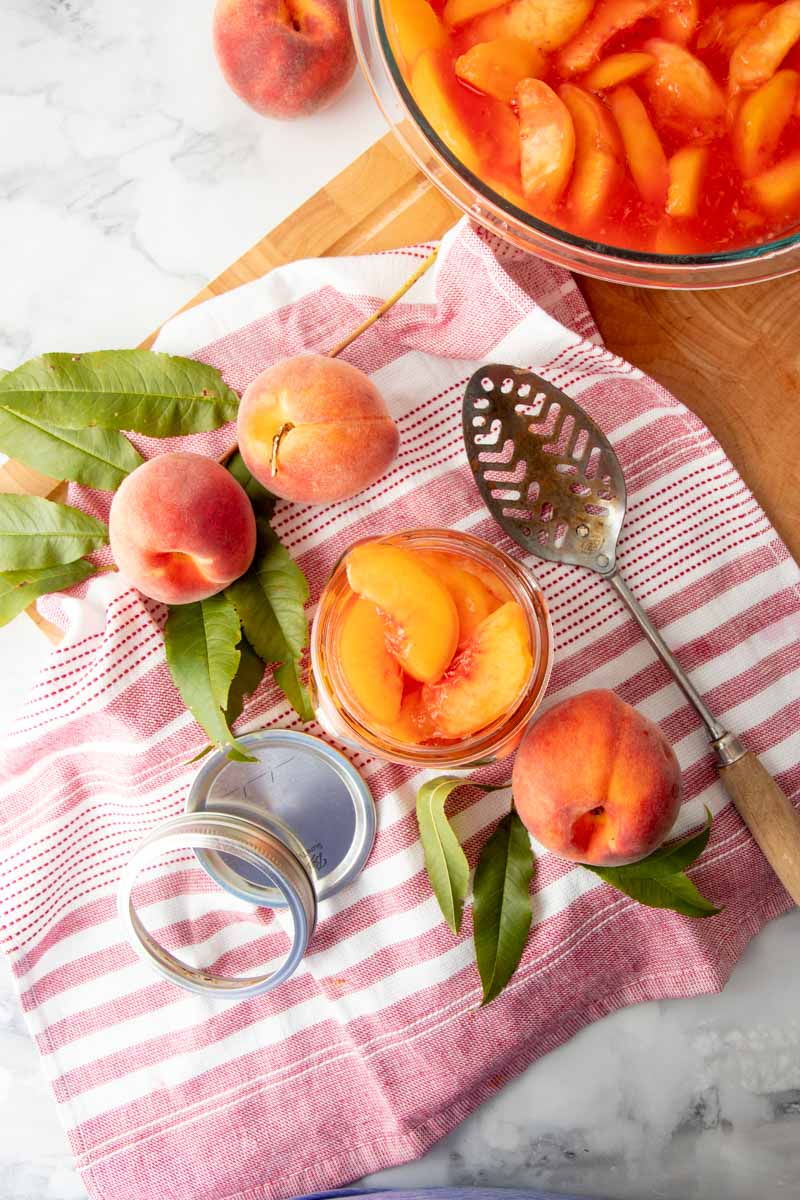
Help! Why did my jars come out of the canner with less liquid?
You’ve just experienced siphoning, and it happens to the best of us from time to time—even experienced canners. Siphoning is when liquid is pulled out of a jar as it cools after canning. If the jars are sealed properly (the lids don’t flex when you press on the center of them), the peaches are still shelf-stable, even if they lose a lot of liquid. However, their quality may fade slightly faster than that of peaches in full jars, so make sure the siphoned jars are at the front of your shelf and get used first.
To reduce the chance of siphoning, slow down the cooling process. When the peaches are done processing in the canner, remove the lid from the canner and turn off the heat. Let the jars sit like that for at least five minutes before taking them out of the water and moving them to a folded towel to cool completely.
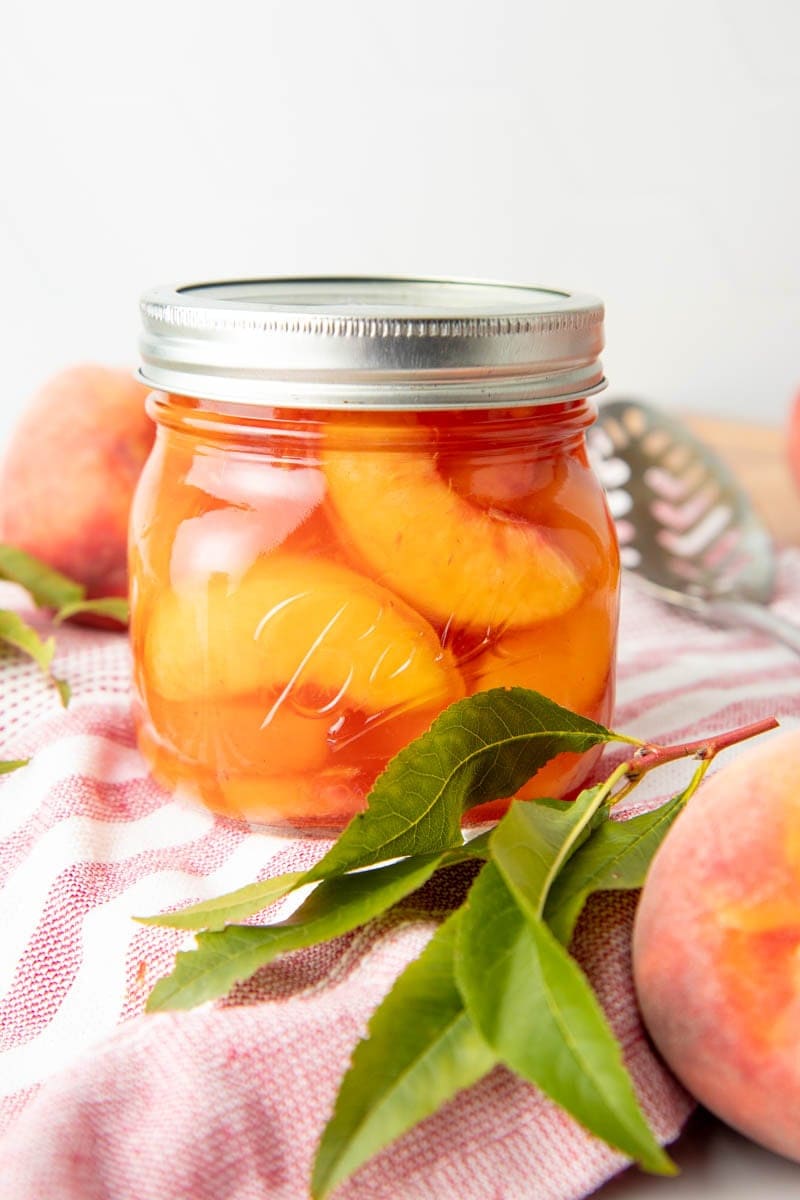
How long after preserving peaches can you eat them?
Technically, you can eat your canned peach slices or halves as soon as the jars cool! But chances are, if you are canning peach slices, peaches are still in season. We recommend that you enjoy the fresh peaches while you can, and save the canned ones for winter!
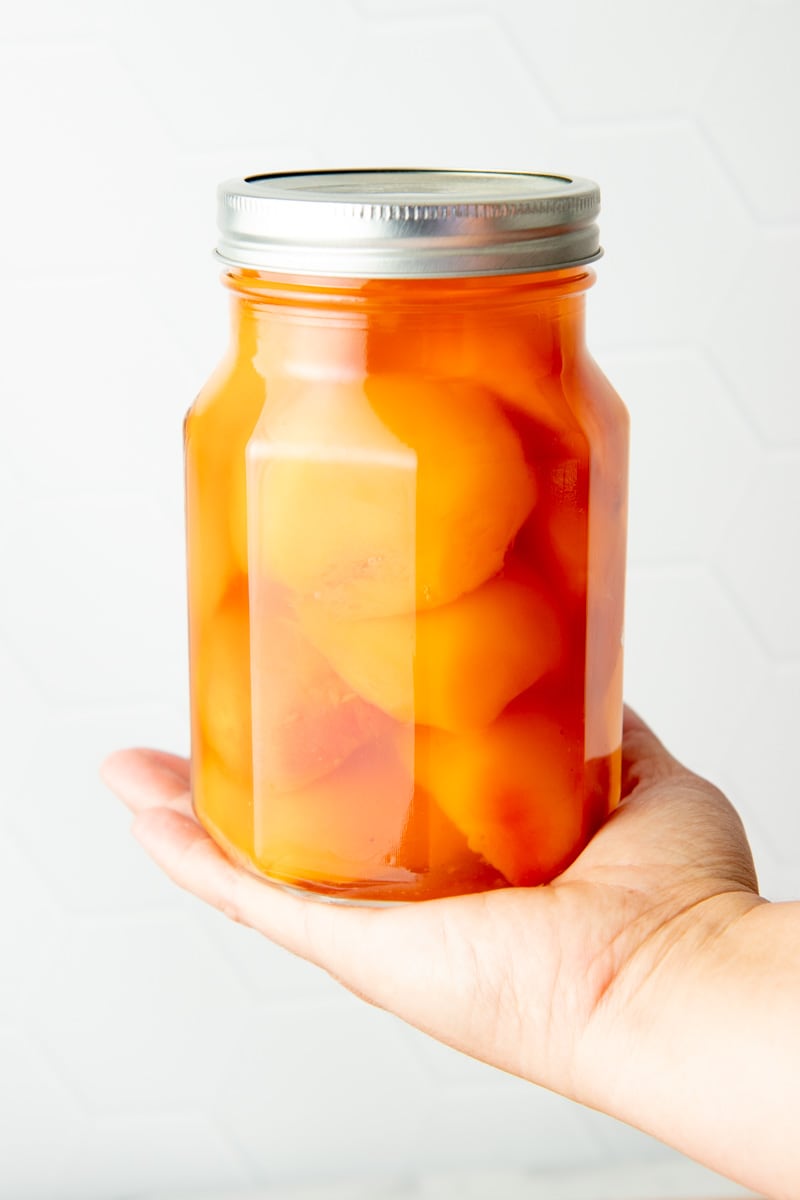
How long are canned peaches good for?
We recommend eating your peaches within 18 months. If properly sealed, peaches can be safely stored nearly indefinitely, but they will start to lose some quality (flavor, texture, or color) around the 18 month mark.
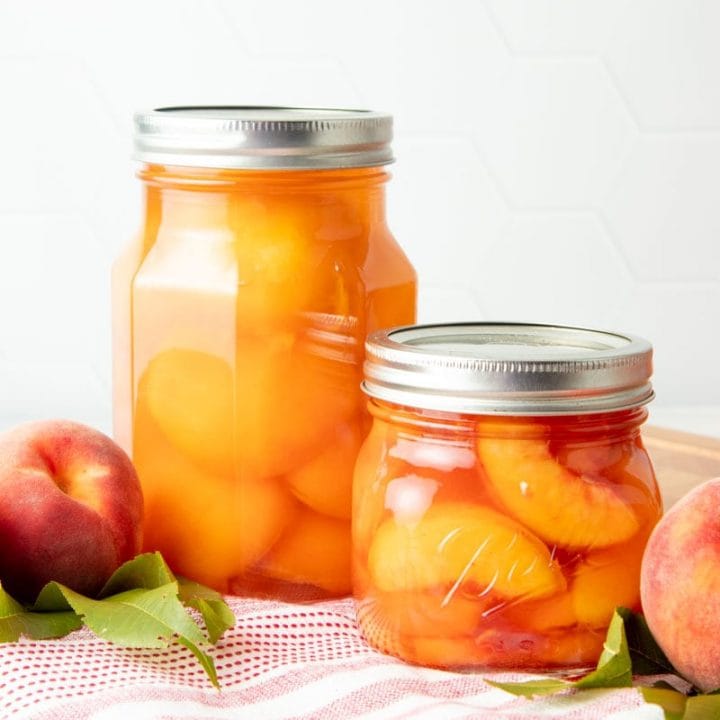
Canning Peaches in Slices or Halves
Canning peaches is a great way to put delicious, homemade peaches on your table in the middle of winter. Follow our step-by-step guide to canning peaches here.
Adapted from the Ball® Complete Book of Home Preserving.
Ingredients
- 8-12 pounds peaches, peeled, halved or sliced, pitted, and treated to prevent browning and drained
- 1 batch hot syrup (see notes)
Instructions
Raw-Pack Method
- Prepare canner, jars, and lids for canning.
- Heat syrup ingredients over medium-high heat until combined and hot. Keep syrup hot during canning.
- Pack peaches into hot jars, stopping 1/2" below the edge of the jar. Peach halves should be packed cavity side down.
- Ladle hot syrup over the peaches, leaving 1/2" headspace. Remove air bubbles and add hot syrup if necessary to bring the headspace back to 1/2".
- Wipe rims of jars, place on the lid, and screw on the band until fingertip tight.
- Place jars in canner, ensuring they are covered by at least one inch of water. Bring to a boil and process pint jars for 25 minutes, or quart jars for 30 minutes.
- Turn off the heat, remove canner lid, and wait 5 minutes before moving the jars to a towel on the counter to cool completely. After 24 hours, check the seal of the lids—if they don't flex when you press on the center, your peaches are safe to store at room temperature.
Hot-Pack Method
- Prepare canner, jars, and lids for canning.
- Heat syrup ingredients over medium-high heat in a large saucpan until combined and hot. Reduce the heat to medium-low.
- Heat peaches in the syrup, one layer at a time, until heated through. It should take about one minute per layer.
- Use a slotted spoon to pack hot peaches (halves should be cavity-side down) into hot jars, stopping 1/2" below the edge of the jar.
- Ladle hot syrup over the peaches, leaving 1/2" headspace. Remove air bubbles and add hot syrup if necessary to bring the headspace back to 1/2".
- Wipe rims of jars, place on the lid, and screw on the band until fingertip tight.
- Place jars in canner, ensuring they are covered by at least one inch of water. Bring to a boil and process pint jars for 20 minutes, or quart jars for 25 minutes.
- Turn off the heat, remove canner lid, and wait 5 minutes before moving the jars to a towel on the counter to cool completely. After 24 hours, check the seal of the lids—if they don't flex when you press on the center, your peaches are safe to store at room temperature.
Notes
- Peaches may be preserved in light syrup, medium syrup, heavy syrup, fruit juice, or even water. See chart within the post for exact ratios and details.
- Hot packing is the preferred method for canning peach halves or slices. Heating the fruit before packing reduces air bubbles.
Nutrition Information:
Yield: 24 Serving Size: 1Amount Per Serving: Calories: 98Total Fat: 1gSaturated Fat: 0gTrans Fat: 0gUnsaturated Fat: 0gCholesterol: 0mgSodium: 2mgCarbohydrates: 24gFiber: 3gSugar: 20gProtein: 2g
At Wholefully, we believe that good nutrition is about much more than just the numbers on the nutrition facts panel. Please use the above information as only a small part of what helps you decide what foods are nourishing for you.

